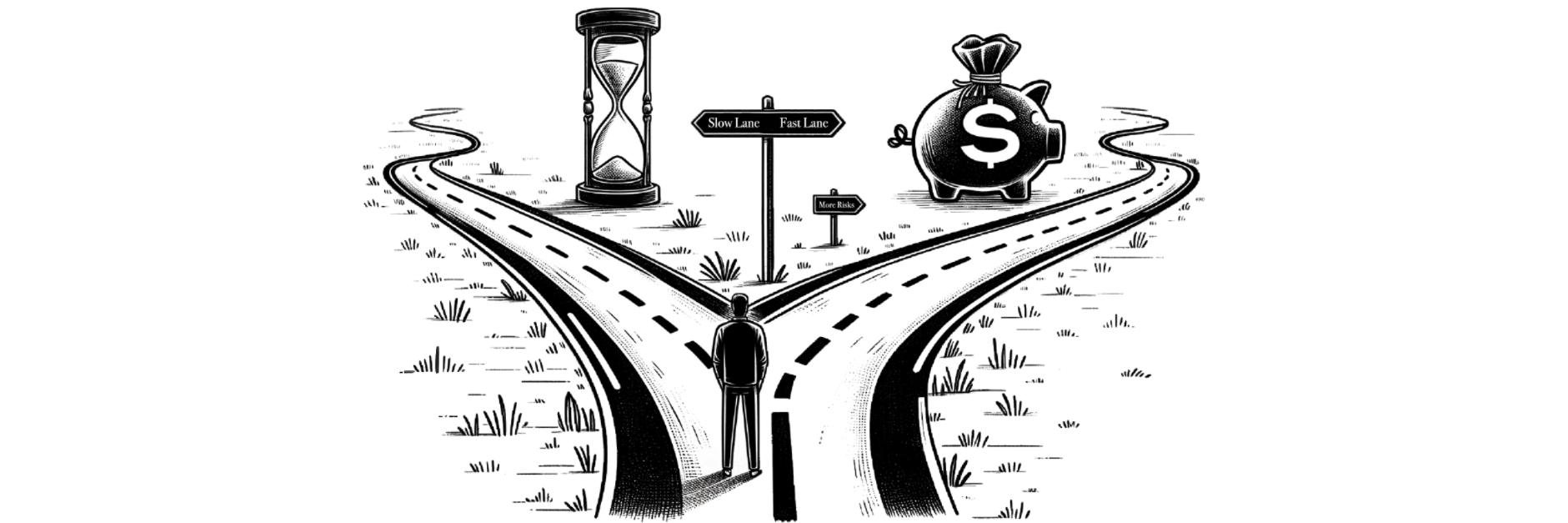Ditch Decades of Saving: Fast-Track to Financial Freedom
If you do not believe the traditional path to wealth of investing in diversified ETFs and compounding the returns for the long term, you’re in for a treat. Today, I will be discussing what I learnt from a book called “The Millionaire Fastlane” by MJ DeMarco, where the author challenges everything I thought I knew about building wealth.
The essence of the Fastlane philosophy challenges traditional financial advice by advocating for rapid wealth accumulation through entrepreneurship, innovation, and strategic investments. Unlike the conventional route, which preaches saving and patience, the Fastlane encourages us to take control of our financial destinies and leverage opportunities for exponential growth.
Every week, I’ll be sharing practical tips and invaluable knowledge to guide you on your path to financial independence.
Understanding the Pathways: Sidewalk, Slowlane, and Fastlane
To truly appreciate the Fastlane, let’s compare the three financial paths that DeMarco described in his book – Sidewalk, Slowlane and Fastlane. The Sidewalk, where financial planning is virtually nonexistent, leads many to live paycheck to paycheck. The Slow Lane, favoured by traditional financial advice, relies on saving a fraction of your income and investing it, hoping it’ll grow over decades. But the Fastlane? It’s all about explosive growth and leveraging business and investment opportunities that can catapult your wealth to new heights.
Singapore presents a microcosm of these financial paths. With a low unemployment rate, I’d argue that most Singaporeans are on the Slowlane, having steady employment and making traditional investments in a diversified portfolio; and a smaller percentage of the population embracing the Fastlane, which epitomises the entrepreneurial spirit that drives rapid wealth creation. In Singapore, the Fastlane is not just a path but a highway, facilitated by the city-state’s vibrant economy and supportive policies for startups and innovators.
The Wealth Formulas of Slowlane and Fastlane
The Slowlane formula is simple: Work for money, save a bit, invest it, and wait. It’s a formula based on the hope that compound interest over decades will work its magic. On the other hand, the Fastlane formula rejects this passive approach. It focuses on creating value, investing in scalable businesses, and using compound interest not as a slow-growing tree but as a powerful engine for wealth multiplication.
Slowlane Wealth Formula
Wealth = (Primary Income Source: Job) + (Wealth Accelerator: Market Investments)
Wealth = Intrinsic Value (Job) + Compound Interest
Intrinsic Value = Hourly Wage * Hours Worked
— Or —
Intrinsic Value = Yearly Salary
Fastlane Wealth Formula
Wealth = Profit + Asset Value
Net Profit = Units Sold (can be scaled) * Unit Profit (can have magnitute/magnified)
~ And ~
Asset Value = Net Profit * Industry Multiple (something like PE ratio)
The distinction between the Slowlane and Fastlane wealth formulas is stark. While the Slowlane relies on a fixed salary and the slow accumulation of wealth through savings and compound interest, the Fastlane strategy in Singapore leverages the ecosystem’s advantages to create and scale businesses rapidly. With early-stage funding and support for innovation significantly surpassing global averages1, Singapore’s environment is ripe for Fastlane success.
Transitioning from Slowlane to Fastlane: The Story of Loo Cheng Chuan
I have discussed the 3 different financial paths – Sidewalk, Slowlane and Fastlane. However, it is important to note that we are not stuck with the financial path that we started with. It is possible to switch lanes, if we spend sufficient effort and time to make the change.
An example of an individual who has transitioned from Slowlane to Fastlane that came to mind is Loo Cheng Chuan, Founder of 1M65.
Based on Loo’s LinkedIn profile, he spent close to 16 years on the Slowlane as an employee of SingTel, climbing the corporate ladder to rise up the ranks. He built a financial safety net by actively topping up his CPF on top of his monthly paycheck, which eventually resulted in the CPF accounts belonging to both his wife and his to accumulate S$1 million by the age of 45.
Having built a financial safety net, Loo has left his employment and transited from Slowlane to Fastlane by starting an e-Commerce business with his wife and is also consultant and advisor to a number of companies well-known companies across the region. This illustrates the power of the Fastlane in Singapore. By leveraging the CPF system to maximize his savings and embracing entrepreneurial ventures, Loo exemplifies how it is possible to make strategic shifts from Slowlane to Fastlane.
The Power of the Choices We Make
In his book, DeMarco writes that the choices we make, hold the key to our financial and personal destiny. He wrote that our lives are fundamentally shaped by the myriad of choices we make every day. From deciding between job offers to starting a business, from choosing where we live to selecting who we spend our time with, each decision sets off a chain reaction that defines our reality. He asserts, “Your choices spark the fires of future circumstances… You act, react, believe, disbelieve, perceive, misperceive, and all of it engineers your existence.”
This concept extends to the “butterfly effect” of choices—how even seemingly minor decisions can have profound impacts over time. DeMarco explains how each choice creates an “impact differential,” leading our paths to diverge more significantly as years pass. This divergence can lead to vastly different financial and personal outcomes, underlining the importance of making informed, strategic decisions at every crossroad.
If we think deeper about the types of choices we make, DeMarco categorizes choices into two types: choices of perception (thought patterns) and choices of action (concrete decisions like choosing to read or start a business). He emphasises that choices of perception often precede and dictate choices of action. Changing your life, therefore, starts with altering your perceptions, which in turn influences your actions. The Fastlane to wealth is driven by these choices, not by mere circumstance or luck.
Simple Decision-Making Tools to Make Better Decisions
The choices we make become decisions that impact our life. To make better decisions, DeMarco suggested in his book, two critical decision-making tools that we can make use of: Worst Case Consequence Analysis (WCCA) and Weighted Average Decision Matrix (WADM). These tools are indispensable for entrepreneurs looking to make calculated moves on their journey to rapid wealth accumulation.
Worst Case Consequence Analysis (WCCA)
WCCA is all about forward-thinking and analysing potential consequences before they happen. It compels us to ask three pivotal questions about every significant decision:
- What is the worst-case consequence of this choice?
- What is the probability of this outcome?
- And, is this an acceptable risk?
By contemplating these questions, we can steer clear of potentially disastrous decisions and better navigate the uncertainties of life.
Weighted Average Decision Matrix (WADM)
On the other hand, WADM is a strategic tool for comparing and quantifying major decisions. Whether contemplating a move, a career change, or any other significant life decision, WADM alows us to isolate and prioritise factors relevant to the decision at hand and then quantify each option with a value that signifies which choice aligns best with your objectives and preferences.
DeMarco provided an example to demonstrate WADM: if deciding between relocating to Detroit or Phoenix, WADM could assign numerical values to each option based on various factors, guiding you to the most favourable choice.
| Factors | Detroit | Phoenix |
| Weather (10) | 2 [20] | 8 [80] |
| Schools (3) | 2 [6] | 3 [9] |
| Cost of Living (6) | 5 [30] | 7 [42] |
| Business Climate (2) | 6 [12] | 4 [8] |
| Taxes (7) | 6 [42] | 7 [49] |
| Safety (4) | 3 [12] | 6 [24] |
| Entertainment (8) | 5 [40] | 2 [16] |
| Near Family (7) | 10 [70] | 0 [0] |
| 232 | 228 |
Applying Decision-Making Tools for the Slowlane-to-Fastlane Shift
If you are contemplating about making the shift from the Slowlane to the Fastlane, applying the decision-making tools of WCCA and WADM can offer profound insights. These tools not only guide you through the complexities of such a pivotal transition but also equip you with a structured approach to evaluating potential risks and outcomes associated with making significant life changes towards accelerated wealth creation.
With its focus on evaluating the worst-case scenarios, WCCA prompts us to think critically about the potential downsides of leaving the relative safety of the Slowlane. By asking oneself about the worst-case outcomes, the probability of these outcomes, and whether these risks are acceptable, one gains a clearer understanding of the personal tolerance for risk and uncertainty. This analysis is crucial for anyone considering a leap into entrepreneurship or more aggressive investment strategies characteristic of the Fastlane. It allows for a forward-thinking mindset, enabling individuals to mitigate risks proactively or to brace for possible challenges without being deterred by fear of the unknown.
On the other hand, WADM provides a quantitative framework to compare the potential benefits of staying in the Slowlane versus venturing into the Fastlane. By assigning values to various factors such as income potential, personal fulfillment, time freedom, and the likelihood of achieving financial independence, individuals can make a more objective decision. This matrix helps in isolating and prioritizing what truly matters to one’s long-term goals and preferences. For someone on the brink of choosing between a steady job and launching a startup, or between traditional investing and more dynamic financial ventures, WADM can illuminate which path aligns more closely with their aspirations and risk appetite, ultimately facilitating a well-informed leap from the Slowlane to the Fastlane.
Conclusion
In wrapping up our understanding of the different financial paths and exploration of transitioning from the Slowlane to the Fastlane, inspired by MJ DeMarco’s “The Millionaire Fastlane,” it’s crucial to reflect on the essence of DeMarco’s concepts and ideas while also acknowledging a vital aspect not deeply delved into within the book — the inherent risks and potential consequences of the Fastlane journey. DeMarco brilliantly illuminates the path to accelerated wealth creation, emphasising the power of entrepreneurial ventures, strategic decision-making, and breaking free from conventional financial wisdom.
However, it’s important for aspiring Fastlaners to remain aware of the fact that entrepreneurship and aggressive investment strategies carry their own set of risks. Not all businesses succeed, and the road to Fastlane wealth is fraught with potential pitfalls and setbacks. The reality of the entrepreneurial journey is that it often involves navigating through failures, learning from mistakes, and persistently adapting to overcome challenges. While the Fastlane promises a route to rapid wealth accumulation, it demands a high tolerance for risk, resilience in the face of adversity, and a commitment to continuous learning and growth.
In conclusion, as we draw inspiration from “The Millionaire Fastlane” to redefine our approach to wealth and success, let’s approach the Fastlane with both ambition and a healthy dose of realism. Understanding the full spectrum of possibilities, including the risks and rewards, equips us to make more informed decisions and better prepare for the journey ahead. Embracing the Fastlane philosophy means not only striving for accelerated financial success but also recognizing and managing the inherent risks of the path less traveled.
Are you inspired by the Fastlane philosophy? Share your thoughts, experiences, or plans to embark on your entrepreneurial journey in the comments below.


Thanks for sharing – I use the Pugh Matrix (a similar approach) for a lot of financial decisions at a personal finance (rent, big purchases) and at work (vendor selection). It helps to narrow down options, reassess your criteria, and… it’s also easily presentable!